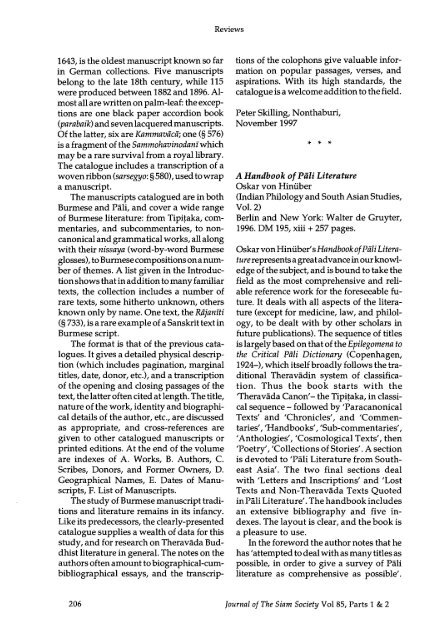The Journal of the Siam Society Vol. LXXXV, Part 1-2, 1997 - Khamkoo
The Journal of the Siam Society Vol. LXXXV, Part 1-2, 1997 - Khamkoo
The Journal of the Siam Society Vol. LXXXV, Part 1-2, 1997 - Khamkoo
Create successful ePaper yourself
Turn your PDF publications into a flip-book with our unique Google optimized e-Paper software.
Reviews<br />
1643, is <strong>the</strong> oldest manuscript known so far<br />
in German collections. Five manuscripts<br />
belong to <strong>the</strong> late 18th century, while 115<br />
were produced between 1882 and 1896. Almost<br />
all are written on palm-leaf: <strong>the</strong> exceptions<br />
are one black paper accordion book<br />
(parabaik) and seven lacquered manuscripts.<br />
Of <strong>the</strong> latter, six are Kammavticti; one(§ 576)<br />
is a fragment <strong>of</strong> <strong>the</strong> Sammohavinodanfwhich<br />
may be a rare survival from a royal library.<br />
<strong>The</strong> catalogue includes a transcription <strong>of</strong> a<br />
woven ribbon (sarsegyo: § 580), used to wrap<br />
a manuscript.<br />
<strong>The</strong> manuscripts catalogued are in both<br />
Burmese and Pali, and cover a wide range<br />
<strong>of</strong> Burmese literature: from Tipitaka, commentaries,<br />
and subcommentaries, to noncanonical<br />
and grammatical works, all along<br />
with <strong>the</strong>ir nissaya (word-by-word Burmese<br />
glosses), to Burmese compositions on anumber<br />
<strong>of</strong> <strong>the</strong>mes. A list given in <strong>the</strong> Introduction<br />
shows that in addition to many familiar<br />
texts, <strong>the</strong> collection includes a number <strong>of</strong><br />
rare texts, some hi<strong>the</strong>rto unknown, o<strong>the</strong>rs<br />
known only by name. One text, <strong>the</strong> Riijanfti<br />
(§ 733), is a rare example <strong>of</strong> a Sanskrit text in<br />
Burmese script.<br />
<strong>The</strong> format is that <strong>of</strong> <strong>the</strong> previous catalogues.<br />
It gives a detailed physical description<br />
(which includes pagination, marginal<br />
titles, date, donor, etc.), and a transcription<br />
<strong>of</strong> <strong>the</strong> opening and closing passages <strong>of</strong> <strong>the</strong><br />
text, <strong>the</strong> latter <strong>of</strong>ten cited at length. <strong>The</strong> title,<br />
nature <strong>of</strong> <strong>the</strong> work, identity and biographical<br />
details <strong>of</strong> <strong>the</strong> author, etc., are discussed<br />
as appropriate, and cross-references are<br />
given to o<strong>the</strong>r catalogued manuscripts or<br />
printed editions. At <strong>the</strong> end <strong>of</strong> <strong>the</strong> volume<br />
are indexes <strong>of</strong> A. Works, B. Authors, C.<br />
Scribes, Donors, and Former Owners, D.<br />
Geographical Names, E. Dates <strong>of</strong> Manuscripts,<br />
F. List <strong>of</strong> Manuscripts.<br />
<strong>The</strong> study <strong>of</strong> Burmese manuscript traditions<br />
and literature remains in its infancy.<br />
Like its predecessors, <strong>the</strong> dearly-presented<br />
catalogue supplies a wealth <strong>of</strong> data for this<br />
study, and for research on <strong>The</strong>ravada Buddhist<br />
literature in general. <strong>The</strong> notes on <strong>the</strong><br />
authors <strong>of</strong>ten amount to biographical-cumbibliographical<br />
essays, and <strong>the</strong> transcrip-<br />
tions <strong>of</strong> <strong>the</strong> colophons give valuable information<br />
on popular passages, verses, and<br />
aspirations. With its high standards, <strong>the</strong><br />
catalogue is a welcome addition to <strong>the</strong> field.<br />
Peter Skilling, Nonthaburi,<br />
November <strong>1997</strong><br />
* * *<br />
A Handbook <strong>of</strong> Piili Literature<br />
Oskar von Hiniiber<br />
(Indian Philology and South Asian Studies,<br />
<strong>Vol</strong>. 2)<br />
Berlin and New York: Walter de Gruyter,<br />
1996. OM 195, xiii + 257 pages.<br />
Oskar von Hiniiber' s Handbook <strong>of</strong> Ptili Literature<br />
represents a great advance in our knowledge<br />
<strong>of</strong> <strong>the</strong> subject, and is bound to take <strong>the</strong><br />
field as <strong>the</strong> most comprehensive and reliable<br />
reference work for <strong>the</strong> foreseeable future.<br />
It deals with all aspects <strong>of</strong> <strong>the</strong> literature<br />
(except for medicine, law, and philology,<br />
to be dealt with by o<strong>the</strong>r scholars in<br />
future publications). <strong>The</strong> sequence <strong>of</strong> titles<br />
is largely based on that <strong>of</strong> <strong>the</strong> Epilegomena to<br />
<strong>the</strong> Critical Ptili Dictionary (Copenhagen,<br />
1924-), which itself broadly follows <strong>the</strong> traditional<br />
<strong>The</strong>ravadin system <strong>of</strong> classification.<br />
Thus <strong>the</strong> book starts with <strong>the</strong><br />
'<strong>The</strong>ravada Canon'- <strong>the</strong> Tipitaka, in classical<br />
sequence - followed by 'Paracanonical<br />
Texts' and 'Chronicles', and 'Commentaries',<br />
'Handbooks', 'Sub-commentaries',<br />
'Anthologies', 'Cosmological Texts', <strong>the</strong>n<br />
'Poetry', 'Collections <strong>of</strong> Stories'. A section<br />
is devoted to 'Pali Literature from Sou<strong>the</strong>ast<br />
Asia'. <strong>The</strong> two final sections deal<br />
with 'Letters and Inscriptions' and 'Lost<br />
Texts and Non-<strong>The</strong>ravada Texts Quoted<br />
in Pali Literature'. <strong>The</strong> handbook includes<br />
an extensive bibliography and five indexes.<br />
<strong>The</strong> layout is clear, and <strong>the</strong> book is<br />
a pleasure to use.<br />
In <strong>the</strong> foreword <strong>the</strong> author notes that he<br />
has 'attempted to deal with as many titles as<br />
possible, in order to give a survey <strong>of</strong> Pali<br />
literature as comprehensive as possible'.<br />
206<br />
<strong>Journal</strong> <strong>of</strong> <strong>The</strong> <strong>Siam</strong> <strong>Society</strong> <strong>Vol</strong> 85, <strong>Part</strong>s 1 & 2

















